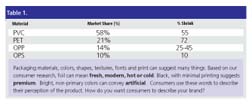
Colors, shapes and pictures can tell you the food (or beverage) is fresh, fun, flavorful, cool, modern and more. Single-serve flavored milks using full-body shrink sleeves (Hershey, Nestle, Dean's) are examples of labels that really connect with the consumer and the retailer and help sell the product. Dean's and Nestle also deserve credit for using labels to enhance package shape and product imagery with their International Delight and Coffee Mate brands, respectively. Remember: The product is the package and the label is critical in the "sell proposition."
According to Packaging Strategies 2005 Packaging Outlook, shrink labels are expected to continue to maintain a 12% annualized growth rate from 2005 to 2007. The primary materials used for shrink labels are polyvinyl chloride (PVC), polyethyleneterephthalate (PET), oriented polypropylene (OPP) and oriented polystyrene (OPS) (see Table 1), an insulated foam.
PVC is the lowest cost and most preferred material, while PET is the highest cost, but offers the largest percentage shrink for varying diameter bottles.
We have made progress with shrink labels in dairy beverages, but the commoditization of sour cream, cream cheese and cottage cheese is embarrassing. Improved labels and color could change these categories dramatically. Have you ever seen a label on any of these foods that suggests fresh, flavorful, fun, modern, cool or convenient? These products all look cost driven, in flimsy tubs, with minimum print and graphics. Why not look at new label options or ideas to enhance the value of the product? After all, dairy is great food! Let's use packaging to help consumers and retailers understand that, too. Below are some label options to consider:
- Foil or holographic sleeves can make the product jump out of the dairy case. Design the sleeve to be interactive and fun with games or other secondary uses.
- Digital printing puts "you" on the picture eating a favorite food like sour cream and cheese quesadillas or cream cheese with a bagel.
- New shapes and colors-rather than old thermoforms for cultured products-take products into the new century and tie in labels to performance. After all, the product side of dairy is making the push.
- New and different labels on fluid milk can turn the 1/2- and 1-gallon size products out of commodity status. Consider some "funky and fun" shapes, sizes, textures and colors. Make a game of collecting all the shapes to complete the puzzle.
- Put shrink sleeves on all products and packages.
These are just a few places where changing the label changes the value equation for the product. Clearly, dairy foods provide consumer benefits, so let's use the package, product and equity to communicate a better value proposition and a superior integrated solution. The converters and packaging trade organizations are working hard to better understand consumers and retailers and are there to help provide the best solutions possible. n
Mike Richmond is president/CEO of Packaging and Technology Integrated Solutions (PTIS), a management consulting company with a fresh approach to packaging. For more information, visit www.pti-solutions.com.